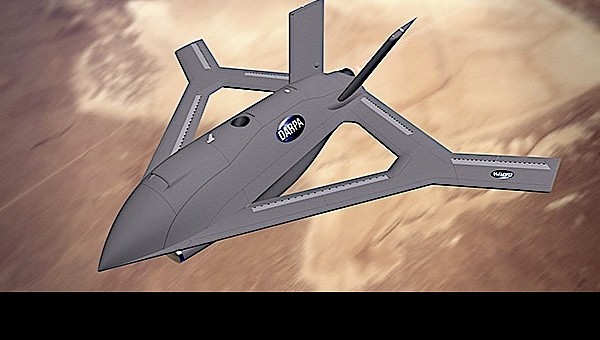This year the world will be celebrating 120 years since the historic first flight of Orville and Wilbur Wright, an event which marked the start of humanity’s expansion into the skies (and later into space) but also went on to create perhaps the most important of modern human industries.
120 years is a long time by any standards, and aviation has evolved greatly since the Kitty Hawk in almost most respects. Yet there is one thing that has largely remained the same over the decades: the overall aircraft design.
Regardless of its maker, an airplane is generally a long tube with a couple of big wings about midway through the cylinder and two more at the rear, backed by a horizontal one. The wings are not only essential in ensuring lift for the airplane, but they’re also the place where most control surfaces are located: stabilizers, rudder, flaps, ailerons, and slats. Those are the things that control the airplane's pitch, yaw, and roll.
Although minor variations have been known to happen, that’s how generally an airplane has been designed since forever. Back in 2019 however, America’s premiere research agency for wacky ideas, DARPA, decided to start a program called Control of Revolutionary Aircraft with Novel Effectors.
CRANE for short, the project aims to create an aircraft design with absolutely no moving flight control surfaces on the wings and tail, and no conventional wings, for that matter. How can one be controlled, then?
Well, it’s all in the program’s name, really: thanks to something called active flow control (AFC) and the use of actuators and effectors. In essence, instead of moving the current control surfaces to direct the flow of air and handle the plane, pilots will use this tech to get extra flow of air over certain parts of the aircraft and get the desired effect.
This method of doing things could allow an aircraft to perform maneuvers considered difficult and even impossible presently, but also experience significant drag reduction and a high angle of attack. Physically, the plane’s wings can be thicker, allowing for more fuel to be carried inside.
The first phase of the program was awarded back in 2020 to Boeing’s research subsidiary Aurora Flight Sciences, and as part of that, a testbed aircraft was created and put through its paces in a wind tunnel.
This week DARPA said it is moving ahead with Aurora and the new plane design. Phase 2 of the project means a detailed design of a demonstrator in X-plane configuration, and also later on the critical design review.
If everything checks out, Phase 3 of the project, yet to be announced, will call for flying a 7,000-pound machine (3,175 kg) machine. The main goal of the test flight will be to uncover whatever obstacles may come in the way of installing AFC technologies on a full-scale machine.
We’re promised a plane (the main photo of this piece is a clear indication of what DARPA has in mind) with modular wing configurations that could allow future and yet undisclosed tech to be integrated into the design. Sadly, no timeline for CRANE Phase 2 was announced.
Regardless of its maker, an airplane is generally a long tube with a couple of big wings about midway through the cylinder and two more at the rear, backed by a horizontal one. The wings are not only essential in ensuring lift for the airplane, but they’re also the place where most control surfaces are located: stabilizers, rudder, flaps, ailerons, and slats. Those are the things that control the airplane's pitch, yaw, and roll.
Although minor variations have been known to happen, that’s how generally an airplane has been designed since forever. Back in 2019 however, America’s premiere research agency for wacky ideas, DARPA, decided to start a program called Control of Revolutionary Aircraft with Novel Effectors.
CRANE for short, the project aims to create an aircraft design with absolutely no moving flight control surfaces on the wings and tail, and no conventional wings, for that matter. How can one be controlled, then?
Well, it’s all in the program’s name, really: thanks to something called active flow control (AFC) and the use of actuators and effectors. In essence, instead of moving the current control surfaces to direct the flow of air and handle the plane, pilots will use this tech to get extra flow of air over certain parts of the aircraft and get the desired effect.
This method of doing things could allow an aircraft to perform maneuvers considered difficult and even impossible presently, but also experience significant drag reduction and a high angle of attack. Physically, the plane’s wings can be thicker, allowing for more fuel to be carried inside.
The first phase of the program was awarded back in 2020 to Boeing’s research subsidiary Aurora Flight Sciences, and as part of that, a testbed aircraft was created and put through its paces in a wind tunnel.
This week DARPA said it is moving ahead with Aurora and the new plane design. Phase 2 of the project means a detailed design of a demonstrator in X-plane configuration, and also later on the critical design review.
If everything checks out, Phase 3 of the project, yet to be announced, will call for flying a 7,000-pound machine (3,175 kg) machine. The main goal of the test flight will be to uncover whatever obstacles may come in the way of installing AFC technologies on a full-scale machine.
We’re promised a plane (the main photo of this piece is a clear indication of what DARPA has in mind) with modular wing configurations that could allow future and yet undisclosed tech to be integrated into the design. Sadly, no timeline for CRANE Phase 2 was announced.












